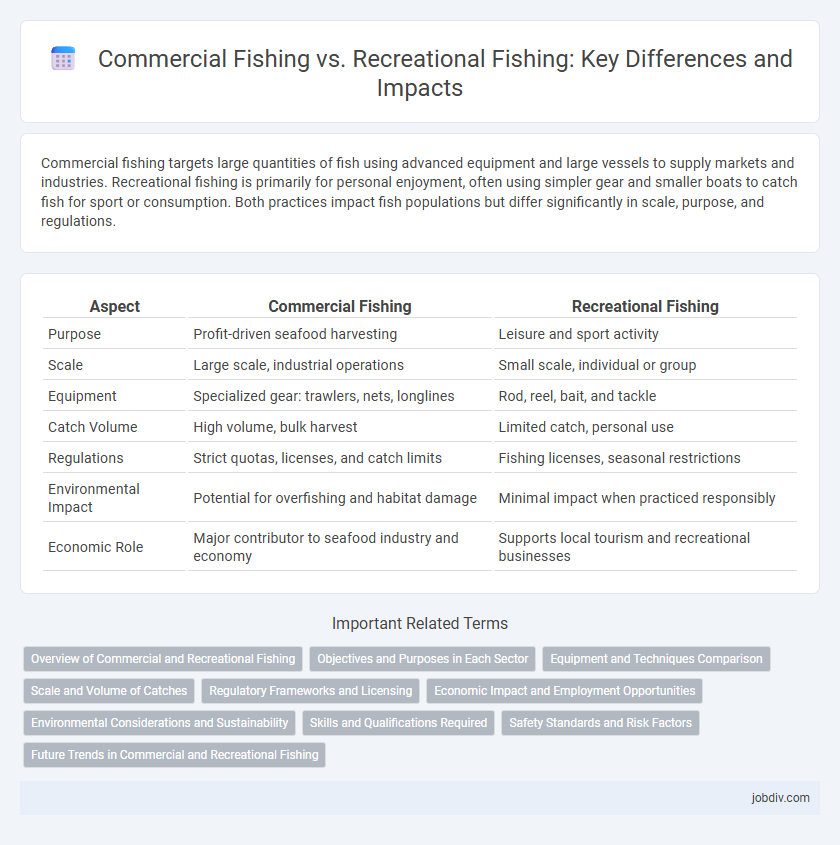Commercial fishing targets large quantities of fish using advanced equipment and large vessels to supply markets and industries. Recreational fishing is primarily for personal enjoyment, often using simpler gear and smaller boats to catch fish for sport or consumption. Both practices impact fish populations but differ significantly in scale, purpose, and regulations.
Table of Comparison
| Aspect | Commercial Fishing | Recreational Fishing |
|---|---|---|
| Purpose | Profit-driven seafood harvesting | Leisure and sport activity |
| Scale | Large scale, industrial operations | Small scale, individual or group |
| Equipment | Specialized gear: trawlers, nets, longlines | Rod, reel, bait, and tackle |
| Catch Volume | High volume, bulk harvest | Limited catch, personal use |
| Regulations | Strict quotas, licenses, and catch limits | Fishing licenses, seasonal restrictions |
| Environmental Impact | Potential for overfishing and habitat damage | Minimal impact when practiced responsibly |
| Economic Role | Major contributor to seafood industry and economy | Supports local tourism and recreational businesses |
Overview of Commercial and Recreational Fishing
Commercial fishing targets large-scale extraction of fish and seafood for sale and distribution, utilizing advanced technology and vessels to harvest vast quantities. Recreational fishing is primarily for personal enjoyment and sport, emphasizing catch-and-release practices or modest catches for consumption. Both methods impact marine ecosystems differently, with commercial fishing often leading to overfishing concerns and recreational fishing contributing to local economies and conservation awareness.
Objectives and Purposes in Each Sector
Commercial fishing primarily aims to supply seafood to markets and support the fishing industry's economic growth by harvesting large quantities of fish using industrial techniques. Recreational fishing focuses on leisure, sport, and personal enjoyment, often emphasizing catch-and-release practices and sustainable interaction with aquatic ecosystems. Objectives in commercial fishing center on profitability and efficiency, whereas recreational fishing prioritizes conservation, experience, and community engagement.
Equipment and Techniques Comparison
Commercial fishing utilizes advanced equipment such as trawlers, large nets, sonar technology, and hydraulic winches to capture vast quantities of fish efficiently, often targeting specific species with precision gear like longlines and purse seines. Recreational fishing relies on simpler, smaller-scale equipment including rods, reels, bait, and tackle boxes, employing techniques like fly fishing, casting, or trolling that focus on leisure and sport rather than volume. The scale and sophistication of commercial gear prioritize production and sustainability management, while recreational methods emphasize personal skill, local regulations, and catch-and-release practices.
Scale and Volume of Catches
Commercial fishing involves large-scale operations utilizing advanced vessels and equipment to harvest millions of metric tons of fish annually, significantly impacting global seafood supply chains. Recreational fishing, characterized by smaller-scale, individual or group activities, accounts for significantly lower catch volumes, primarily targeting local populations and sustaining subsistence levels. The disparity in catch volume between commercial fleets and recreational anglers highlights the economic and ecological influence of industrial fishing on marine ecosystems.
Regulatory Frameworks and Licensing
Commercial fishing is governed by stringent regulatory frameworks designed to manage fish stocks sustainably and ensure economic viability, often requiring specific permits, quotas, and adherence to catch limits set by federal and state agencies. Recreational fishing regulations focus on conservation and public enjoyment, typically involving licenses with size, bag limits, and seasonal restrictions to protect vulnerable species and habitats. Both sectors must comply with monitoring and reporting requirements, but commercial fishing faces more complex compliance due to larger-scale operations and trade implications.
Economic Impact and Employment Opportunities
Commercial fishing significantly contributes to the global economy, generating billions in revenue and supporting millions of jobs in processing, distribution, and export sectors. Recreational fishing stimulates local economies through tourism, licensing fees, and equipment sales, creating seasonal employment and boosting small businesses in coastal communities. Both sectors play crucial roles in economic sustainability, with commercial fishing driving large-scale industry growth and recreational fishing enhancing community-level economic activities.
Environmental Considerations and Sustainability
Commercial fishing often involves large-scale operations that can lead to overfishing and habitat destruction, significantly impacting marine ecosystems and biodiversity. Recreational fishing typically targets fewer fish and uses selective methods, reducing environmental strain and promoting sustainable fish populations. Sustainable fishing practices, such as enforcing quotas and using eco-friendly gear, are crucial for both sectors to preserve ocean health and ensure long-term resource availability.
Skills and Qualifications Required
Commercial fishing demands advanced skills in navigation, vessel operation, and knowledge of fishing regulations to ensure safety and compliance during large-scale, often hazardous, expeditions. Recreational fishing requires basic angling skills, such as casting, knot tying, and species identification, typically learned through practice or guided instruction. Professional certification and licensing are mandatory for commercial fishermen, while recreational anglers often need only a fishing license, emphasizing differing qualification levels.
Safety Standards and Risk Factors
Commercial fishing involves stringent safety standards due to high-risk factors such as heavy machinery, harsh weather, and long hours at sea, leading to mandatory regulations on vessel stability and crew training. Recreational fishing typically encounters fewer hazards but still requires adherence to personal safety measures like life jackets and weather awareness to mitigate risks. Both sectors emphasize safety, yet commercial fishing faces more rigorous oversight given its industrial scale and complexity.
Future Trends in Commercial and Recreational Fishing
Emerging technologies like AI-driven fish tracking and sustainable aquaculture are reshaping commercial fishing by enhancing efficiency and reducing environmental impact. Recreational fishing sees a rise in eco-friendly gear and digital apps that promote catch-and-release practices and habitat conservation. Both sectors increasingly prioritize sustainability, driven by regulatory changes and growing public awareness of marine ecosystem health.
Commercial Fishing vs Recreational Fishing Infographic

 jobdiv.com
jobdiv.com